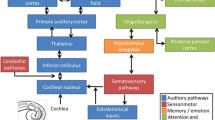Abstract
Cortical attention and habituation parameters are altered in patients suffering from tinnitus. The aim of the study was to quantify cortical attention and habituation parameters in tinnitus patients by recording the contingent negative variation (CNV) response and to correlate amplitudes of different CNV parameters with duration of disease. Twenty patients suffering from tinnitus (median: 44 years) and twenty age- and sex-matched healthy controls (median: 41 years) were tested by a CNV paradigm. We recorded overall CNV, initial CNV, and terminal CNV and calculated habituation slopes. All CNV parameters were Spearman-correlated with individual duration of disease. Highly significant between groups differences emerged in total (tinnitus: −8.4 uV vs. controls: −3.8 uV), initial (−11.2 vs. −6.0 uV), and terminal CNV (−11.9 vs. −6.5 uV) demonstrating higher negative amplitudes in tinnitus patients. Habituation differed in total and terminal CNV, indicating missing habituation in tinnitus patients. Overall CNV (ϱ = −.365) and initial CNV (ϱ = −.529) showed a medium Spearman correlation with duration of disease. We conclude that the correlation between duration of tinnitus and the initial CNV amplitudes indicates an altered state of cortical excitability that can also be observed in more negative CNV-amplitudes in tinnitus patients. We assume that this state indicates a chronicity process in tinnitus disease.



Similar content being viewed by others
References
Bauer, L. O., Costa, L., & Hesselbrock, V. M. (2001). Effects of alcoholism, anxiety and depression on P300 in women: A pilot study. Journal of the Study of Alcohol, 62(5), 571–579.
Böcker, K. B. E., Timsit-Berthier, M., Schoenen, J., & Brunia, C. H. M. (1990). Contingent negative variation in migraine. Headache, 30, 604–609.
Darabaneanu, S., Kropp, P., Niederberger, U., Strenge, H., & Gerber, W. D. (2008). Effects on pregnancy on slow cortical potentials in migraine patients and healthy controls. Cephalalgia, 28(10), 1053–1060.
Eggermont, J. J. (2006). Cortical tonotopic map reorganization and its implications for treatment of tinnitus. Acta Otolaryngologica, Suppl, 556, 9–12.
Evers, S., Quibeldey, F., Grotemeyer, K. H., Suhr, B., & Husstedt, I. W. (1999). Dynamic changes of cognitive habituation and serotonin metabolism during the migraine interval. Cephalalgia, 19(5), 485–491.
Gerber, W. D., & Schoenen, J. (1998). Biobehavioral correlates in migraine: the role of hypersensitivity and information-processing dysfunction. Cephalalgia, 18(Suppl 21), 5–11.
Haab, L., Wallhäuser-Franke, E., Trenado, C., & Strauss, D. J. (2009). Modeling limbic influences on habituation deficits in chronic tinnitus aurium. In 31st annual international conference of the IEEE EMBS, pp. 4234–4237.
Hallam, R. S. (1987). Psychological approaches of the evaluation and management of tinnitus distress. In J. W. P. Hazell (Ed.), Tinnitus (pp. 156–175). Edinburgh: Churchill Livingstone.
Heller, A. (2003). Classification and epidemiology of tinnitus. Otolaryngologic Clinics of North America, 36, 239–248.
Holmes, S., & Padgham, N. D. (2009). Review paper: More than ringing in the ears: a review of tinnitus and its psychosocial impact. Journal of Clinical Nursing, 18, 2927–2937.
Jastreboff, P. J. (1999). Clinical implications of the neurophysiological model of tinnitus. In G. E. Reich & J. A. Vernon (Eds.), Proceedings of the fifth international tinnitus seminar (pp. 500–506). Portland, OR: American Tinnitus Association.
Kaltenbach, J. A., Zhang, J., & Finlayson, P. (2005). Tinnitus as a plastic phenomenon and its possible neural underpinnings in the dorsal cochlear nucleus. Hearing Research, 206, 200–226.
Kropp, P., & Gerber, W. D. (2005). Slow cortical potentials and migraine: Predictive value and possible novel therapeutic strategies to prevent an attack. Functional Neurology, 20(4), 193–197.
Kropp, P., Kiewitt, A., Göbel, H., Vetter, P., & Gerber, W. D. (2000). Reliability and stability of contingent negative variation. Applied Psychophysiology and Biofeedback, 25(1), 33–41.
Kropp, P., Siniatchkin, M., & Gerber, W. D. (2002). On the pathophysiology of migraine—links for “empirically based treatment” with neurofeedback. Applied Psychophysiology and Biofeedback, 27, 203–213.
Landgrebe, M., Langguth, B., Rosengarth, K., Braun, S., Koch, A., Kleinjung, T., et al. (2009). Structural brain changes in tinnitus: Grey matter decrease in auditory and non-auditory brain areas. Neuroimage, 46(1), 213–218.
May, A. (2008). Chronic pain may change the structure of the brain. Pain, 137(1), 7–15.
Mühlau, M., Rauschecker, J. P., Oestreicher, E., Gaser, C., Röttinger, M., Wohlschläger, A. M., et al. (2006). Structural brain changes in tinnitus. Cerebral Cortex, 16, 1283–1288.
Schmidt-Wilcke, T., Leinisch, E., Straube, A., Kämpfe, N., Draganski, B., Diener, H. C., et al. (2005). Gray matter decrease in patients with chronic tension type headache. Neurology, 8(65/9), 1483–1486.
Schoenen, J., Ambrosini, A., Sandor, P. S., & Maertens de Noordhout, A. (2003). Evoked potentials and transcranial magnetic stimulation in migraine: Published data and viewpoint on their pathophysiologic significance. Clinical Neurophysiology, 114(6), 955–972.
Shiraishi, T., Sugimoto, K., Kubo, T., Matsunaga, T., Nageishi, Y., & Simokochi, M. (1991). Contingent negative variation enhancement in tinnitus patients. American Journal of Otolaryngology, 12, 267–271.
Siniatchkin, M., & Kuppe, A. (2011). Neurophysiological determinants of tic severity in children with chronic motor tic disorder. Applied Psychophysiology and Biofeedback, 36, 121–127.
Stankewitz, A., & May, A. (2009). The phenomenon of changes in cortical excitability in migraine is not migraine-specific—a unifying thesis. Pain, 145, 14–17.
Strehl, U., Leins, U., Goth, G., Klinger, C., Hinterberger, T., & Birbaumer, N. (2006). Self-regulation of slow cortical potentials: A new treatment for children with attention-deficit/hyperactivity disorder. Pediatrics, 118(5), 1530–1540.
Thompson, R., & Logan, C. (1996). Memory and learning. In R. Greger & U. Windhorst (Eds.), Comprehensive human physiology (pp. 1161–1182). Berlin, Germany: Springer.
Walpurger, V., Hebing-Lennartz, G., Denecke, H., & Pietrowsky, R. (2003). Habituation deficit in auditory event-related potentials in tinnitus complainers. Hearing Research, 181(1–2), 57–64.
Zenner, H. P., Pfister, M., & Birbaumer, N. (2006). Tinnitus sensitization: Sensory and psychophysiological aspects of a new pathway of acquired centralization of chronic tinnitus. Otology & Neurootology, 27, 1054–1063.
Author information
Authors and Affiliations
Corresponding author
Rights and permissions
About this article
Cite this article
Kropp, P., Hartmann, M., Barchmann, D. et al. Cortical Habituation Deficit in Tinnitus Sufferers: Contingent Negative Variation as an Indicator of Duration of the Disease. Appl Psychophysiol Biofeedback 37, 187–193 (2012). https://doi.org/10.1007/s10484-012-9193-2
Published:
Issue Date:
DOI: https://doi.org/10.1007/s10484-012-9193-2




